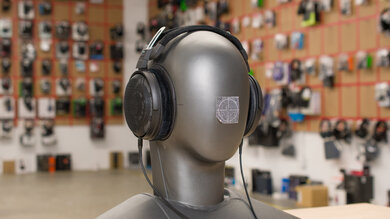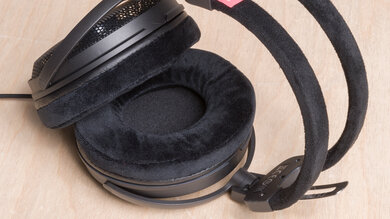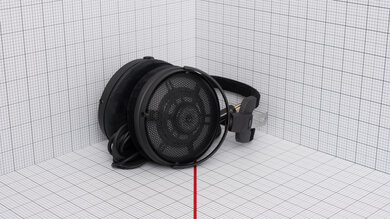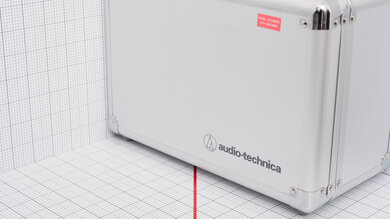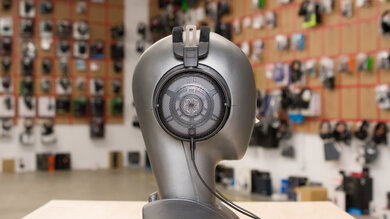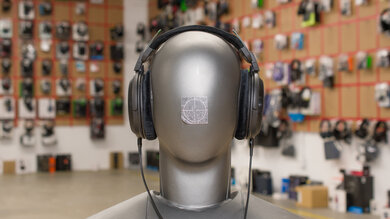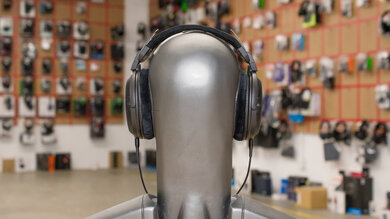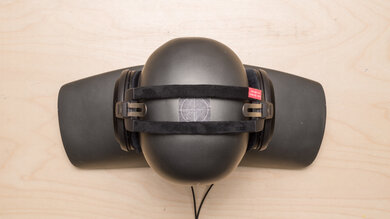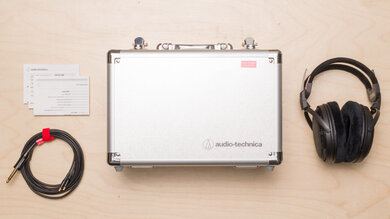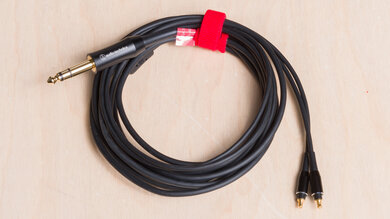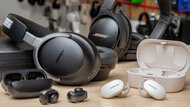The Audio-Technica ATH-ADX3000 are high-end open-back headphones designed for audiophiles seeking a spacious and detailed sound. They're a more affordable cousin to the brand's top-of-the-line Audio-Technica ATH-ADX5000 but are still made from premium-feeling materials such as lightweight magnesium alloy and plush velour. Also, the driver units are all handmade in Audio-Technica's Michada, Tokyo, facility.
Our Verdict
The Audio-Technica ATH-ADX3000 aren't designed for sports and fitness use. They can't be used wirelessly, and their cable might snag on gym equipment. While they are fairly lightweight for audiophile headphones, they're still bulky, and their open-back grilles are vulnerable to sweat and dust. Those same grilles mean they leak a lot of audio and block out very little, which makes them a poor choice for use outside or in a gym.
-
Comfortable fit.
-
Open-back design leaks a lot of audio.
-
Bulky, wired design not well-suited to moving around while wearing the headphones.
The Audio-Technica ATH-ADX3000 aren't really meant for commuting or travel. Though well-built, comfortable, and lightweight, their bulky, wired design makes them inconvenient to carry. Their open-back build also offers minimal noise isolation and leaks a lot of audio, meaning you'll disturb those around you in public spaces.
-
Comfortable fit.
-
Open-back design leaks a lot of audio.
-
Bulky, wired design not well-suited to moving around while wearing the headphones.
The Audio-Technica ATH-ADX3000 are a poor choice for office work. Their open-back design provides little isolation from background noise like office chatter, which means they also leak a lot of sound, so anyone nearby will hear your audio. They also don't have a built-in mic for conference calls. That said, they're lightweight and comfortable enough for long workdays, so if you work in a private office or room and have an external microphone, they'd do the job.
-
Comfortable fit.
-
No built-in mic.
-
Open-back design leaks a lot of audio.
The Audio-Technica ATH-ADX3000 can't be used wirelessly.
The Audio-Technica ATH-ADX3000 are okay for wired gaming. If you can plug their cable into your PC's soundcard or console's controller, they'll do a good job delivering high-quality audio to you with negligible latency. Their balanced mid-range ensures voices and soundtracks sound accurate and detailed, while their very well-matched left and right drivers ensure objects like enemy fighters are accurately located in the stereo field. That said, they lack a built-in microphone, so you'll need an external mic or an aftermarket cable with an in-line mic for voice chat.
-
Comfortable fit.
-
Well-built but still lightweight design.
-
No built-in mic.
-
Open-back design leaks a lot of audio.
The Audio-Technica ATH-ADX3000 have good audio reproduction accuracy. They don't deviate much from their bright sound profile through the bass and mid-range, although some peaks in the treble region can render sibilants a bit piercing. Their left and right drivers are well-matched, so objects are accurately placed in the stereo field, and they have remarkably low distortion, ensuring your audio is reproduced cleanly and accurately. Although their open-back design means your audio feels quite spacious, these headphones don't produce audio that sounds like it's coming from angled reference monitors in an acoustically-treated room.
The Audio-Technica ATH-ADX3000 are open-back headphones. As such, they're designed to let your audio mingle with your environment. You'll hear any noise around you almost as well with these on as with them off.
The Audio-Technica ATH-ADX3000 don't have a built-in mic.
The Audio-Technica ATH-ADX3000 have great frequency response consistency. As long as you take the time to seat these on your head properly each time you put them on, you'll get consistent audio with every wear.
- 5.9 Sports And Fitness
- 4.5 Travel
- 3.0 Office Work
- 4.6 Wireless Gaming (In Development)
- 6.7 Wired Gaming (In Development)
Performance Usages
- 7.6 Audio Reproduction Accuracy
- 1.0 Noise Isolation
- 0 Microphone (In Development)
- 8.3 Frequency Response Consistency
Changelog
-
Updated Jul 29, 2025:
We've updated the Sound Profile box with a link to a downloadable folder of EQ settings that will help you match these headphones' frequency response to different target curves available in our Graph Tool.
-
Updated May 16, 2025:
This review has been updated to Test Bench 2.0, which adds the following tests: Stereo Mismatch, Group Delay, Cumulative Spectral Decay, PRTF, Harmonic Distortion, and Electrical Aspects. We've added new performance usages and updated the text throughout the Sound tests and side-by-sides.
- Updated May 14, 2025: We've converted this review to Test Bench 2.0, which updates our sound tests and adds performance usages. You can read more about this in our changelog.
- Updated Mar 26, 2025: Review published.
- Updated Mar 21, 2025: Early access published.
Check Price
Differences Between Sizes And Variants
These headphones come in a single variant: 'Black.' Here is a picture of their label.
If you encounter another variant of these headphones, please let us know in the comments, and we'll update our review.
Popular Headphones Comparisons
The ATH-ADX3000 are a more affordable version of Audio-Technica's flagship audiophile headphones, the Audio-Technica ATH-ADX5000. As open-back, wired headphones, they're competing against high-quality offerings from the likes of Sennheiser, Beyerdynamic, and HiFiMan. In terms of tonality, these edge closer to something like the Beyerdynamic DT 1990 PRO MKII than the smoother sound of the Sennheiser HD 490 PRO. And let's be clear: once you're spending big money on a pair of headphones from these sorts of reputable brands, measurements can only tell you so much. Yes, technical flaws like too much distortion or poor imaging are best avoided, but sound profile is a personal choice, as is the use case. For instance, open-back headphones with short cables aren't very useful for recording.
But if you like the idea of the ATH-ADX3000's slightly bright, detailed sound but are looking for headphones with a more speaker-like soundstage, the Sennheiser HD 800 S are a worthy, if expensive, upgrade. If your budget can't quite stretch to the Audio-Technica, the aforementioned Beyerdynamic are also a great pick. On the other hand, if you prefer warmer headphones, it's worth checking out the Sennheiser HD 650 or the Audeze MM-100.
If you're searching for audiophile-grade or professional headphones, check out our articles for the best open-back headphones, the best audiophile headphones, and the best studio headphones.
The Audio-Technica ATH-ADX3000 and the Audio-Technica ATH-M50x are very different headphones. For a start, the open-backed ADX3000 are many times more expensive than the closed-back M50x, but they serve different purposes. The M50x are a great choice for use while recording or for listening to music on the go (so long as you don't mind the cable). On the other hand, the ADX3000's more open sound and remarkable imaging performance make them a good choice for critical listening work such as audio editing.
The Audio-Technica ATH-ADX3000 are much more expensive headphones than the HiFiMan Edition XS, but they serve similar purposes. Both pairs are open-back headphones that target audiophile listeners or audio professionals such as mix engineers. Fans of a brighter sound will likely prefer the Audio-Technica's extra detail in the treble region, while bass-heads should turn to the HiFiMan, which puts out noticeably more thump. If we had to pick, we'd say the HiFiMan are the better deal, but sound preference is personal.
The Audio-Technica ATH-ADX3000 and the Sennheiser HD 800 S are both high-end open-back headphones. The Sennheiser are the better headphones: they have a more balanced treble range and a more speaker-like sound. But they also cost a lot more than the Audio-Technica, which still offer a remarkably accurate mid-range. Some listeners may even prefer the Audio-Technica's brighter sound, but in this case, budget is likely the decisive factor.
The Audio-Technica ATH-ADX3000 and the Sennheiser HD 490 PRO are both audiophile-grade open-back headphones, but they target slightly different markets. The Audio-Technica are more expensive than the Sennheiser and are a better choice for fans of a balanced but bright sound. On the other hand, the cheaper Sennheiser offer a bit more low-end thump and have a more controlled treble, which some may find smoother.
The Audio-Technica ATH-ADX3000 and the Beyerdynamic DT 1990 PRO MKII are remarkably similar headphones. Both of these open-backed headphones combine a fantastically balanced mid-range with a slightly bright treble, but the Beyerdynamic are notably cheaper than the Audio-Technica. That said, the Audio-Technica have a more immersive, open soundstage and are lighter to wear.

We've upgraded our Headphones Test Bench to 2.0! This update brings several key changes to our tests and usages, making it easier than ever to interpret our sound results based on your personal preferences. You'll also find a brand-new interactive graph tool featuring multiple targets (including our own!) for you to explore and compare.
For a full breakdown, check out our changelog, which includes detailed commentary from our test designer explaining the rationale behind our update.
We'd also love to hear your thoughts: your feedback helps us keep improving, so join us in the comments!
Test Results
The Audio-Technica ADX3000 have a bright sound profile. It's closer to the SoundGuys.com Studio Curve target than our own, largely because that curve favors a controlled, fairly subdued bass, which audio engineers sometimes prefer. Regardless, the mid-range is well-balanced, meaning these headphones accurately reproduce a wide variety of audio content. In general, the sound profile suits listeners who prefer a bright, airy sound profile.
If you'd like to tweak the headphones' frequency response to match some of the target curves on our Graph Tool, check out our downloadable folder of EQ parameters.
The Audio-Technica ADX3000 have great frequency response consistency. The bass response varies a little with the size of your head and whether or not you have long hair or wear glasses, but the variation is low. As long as you take time to seat these correctly each time you put them on, you'll get a consistent sound with each wear.
These headphones offer good compliance with our bass target. Their open-back design means sounds like 808s are robbed of some thump, and kick drums lack just a touch of punch in the mid-bass. Still, their high bass is well-balanced, so basslines in songs like Dua Lipa's Don't Start Now have just the right amount of warmth without muddying up mid-range sounds like voices.
These headphones have outstanding mid-range target compliance. The whole region is remarkably even and flat, ensuring voices and instruments alike are reproduced accurately. Acoustic instruments in songs like Toumani Diabate's Si Naani sound natural and life-like.
The treble compliance is impressive. A big peak in the low-treble means the upper harmonics of vocals can sometimes sound harsh. Similarly, a couple of small dips and a larger peak in the mid-treble means sibilants can sound piercing, depending on their pitch. In general, these headphones have an airy, sparkly quality.
These headphones offer a decent peaks and dips performance. They don't deviate much from the bright sound profile through the bass and mid-range. But a big peak in the low-treble can make voices sound a touch harsh, while a dip and a peak in the mid-treble mean sibilants can sound alternately dull or piercing, depending on their pitch.
These headphones have very well-matched left and right drivers. To obtain our final graph, we averaged the results from three passes (here, here, and here). When averaged, the phase response mismatch graph falls within the audibility threshold. There are still some small deviations in amplitude response across the high-mids and low-treble regions, but we don't expect you to notice any issues with real-world audio content.
These headphones have decent group delay performance. While there is almost no group delay through the mid-range and treble regions, ensuring well-defined transient reproduction, the group delay in the bass region skirts the audibility threshold, making sounds like 808 kick drums feel a little loose.
The Audio-Technica ATH-ADX3000 offer some interaction with your outer ear, which makes sense as they're over-ear, open-back headphones designed to sit around your ear cups. However, the audio they produce doesn't sound very much like a pair of angled reference monitors. If you're in search of headphones that do a better job on that front, consider the Sennheiser HD 800 S.
These headphones have remarkably low harmonic distortion, even when playing back audio at high levels. You can expect clean and pure audio reproduction.
These headphones don't require an amp to drive them during wired use.
These are the settings used to test these headphones. Our results are only valid when used in this configuration.
These over-ear headphones have a sleek, modern look. Their lightweight magnesium alloy frame means these headphones weigh notably less than comparable offerings from rival brands, such as the Beyerdynamic DT 1990 PRO MKII. The ear cups and headband are adorned with soft velour padding. Their open-back design showcases the large 58 mm driver components in each ear cup., which are located behind the honeycombed housing.
The Audio-Technica ATH-ADX3000 are ultra-light, and most people will find them comfortable. They have well-padded, large ear cups that are easy to adjust on your head. However, the headband lacks plush padding, using only a velour wrap, which may cause fatigue over time, especially for people with larger heads. The ear cups swivel, which helps you find the right fit. But, while the headband offers a good range of sizes with distinct notches for easy adjustment, the notches are spaced about 3.5 mm apart, making precise adjustments harder for some users. Headphones like the AKG K361 offer much more precise fits.
The Audio-Technica ADX3000 come with a massive carrying case that is designed more for protection than convenience. It features foam cutouts that securely hold the headphones and cable in place, preventing damage from drops or falls. Its hard exterior shell locks tightly shut with a clamp closure, making it excellent for transporting your headphones safely, but it's not something you'd want to use every day.
The Audio-Technica ADX3000 have a great build quality, so long as they're used for their intended purpose of indoor listening. They're made from durable-feeling materials like aluminum, plastic, velvet, and cloth, and their thick cable seems like it will resist fraying. The plastic hinges do seem a little fragile, but they're smooth and quiet with a good range of motion.
That said, while the yokes feature decent notches for adjustment, they can be tricky to adjust, and the proprietary cable connectors seem fragile and could be damaged if mishandled. The headphones also lack an IP rating for water or dust resistance, so use them outdoors at your peril.
These open-back headphones block out almost no noise, but then they're not designed to. With these on, you'll hear a slight reduction in the high frequencies of any sounds around, so the sound of a nearby A/C fan will be attenuated a little. But you'll hear anything with a lower pitch, such as a nearby conversation, loud and clear.
These open-back headphones aren't built for noise isolation. In fact, you'll likely hear any nearby sounds almost as well with these on as with them off. Car horns, pedestrian chatter, and coworkers tapping on keyboards come through loud and clear, with the headphones blocking out just a little of the very highest audible frequencies.
These headphones have terrible leakage performance, but that's by design. Their open-back design leaks audio into the room around you, so anyone nearby will hear a thin-sounding version of your audio.
These headphones connect to your audio source via a 1/4" jack. The cable itself is stiffer, making it resistant to kinks and tangling. Some listeners might prefer a more malleable cable, but firmer cables are less likely to get tangled.
It's worth noting that the cable connects to each ear cup via Audio-Technica's custom A2DC connector. Since it's a custom piece, it might be harder to find replacements than standard connectors.
If you have a 1/4-inch port on your PC's audio interface, you can plug these in and receive audio, but you'll need an external microphone for audio input.
These headphones aren't a great choice for PlayStation gaming, as they don't come with an 1/8" jack for audio delivery, nor do they come with a microphone.
These headphones aren't a good option for console gaming because they only come with a 1/4" jack, and you'll need an external microphone for voice input.
Comments
Audio-Technica ATH-ADX3000: Main Discussion
Let us know why you want us to review the product here, or encourage others to vote for this product.
Update: We’ve added a link to the recently reviewed eero 7 in the Dimensions section.
- 32120
Are you planning on adding Wi-Fi coverage “heat” maps? I wonder how the BE230 compares to the TP-Link Archer AX55.
Hello, Thank you for your interest in our router reviews. We don’t plan to include heatmaps in new reviews in the near future, as we’re still working on finding a more consistent way to test that aspect. However, I’ve noted your interest and will pass it along to the team.
- 21010
Are you planning on adding Wi-Fi coverage “heat” maps? I wonder how the BE230 compares to the TP-Link Archer AX55.
Update: We’ve added a link to the recently reviewed eero 7 in the Dimensions section.
- 32120
Are you planning on adding Wi-Fi coverage “heat” maps? I wonder how the BE230 compares to the TP-Link Archer AX55.
Hello, Thank you for your interest in our router reviews. We don’t plan to include heatmaps in new reviews in the near future, as we’re still working on finding a more consistent way to test that aspect. However, I’ve noted your interest and will pass it along to the team.
- 21010
Are you planning on adding Wi-Fi coverage “heat” maps? I wonder how the BE230 compares to the TP-Link Archer AX55.



